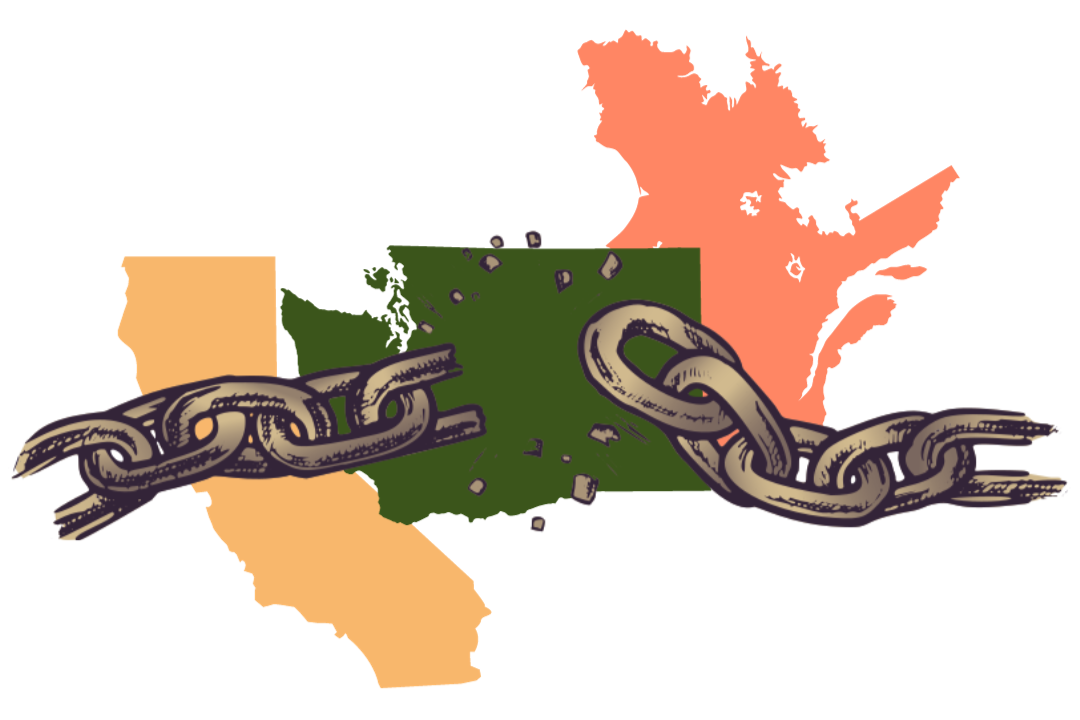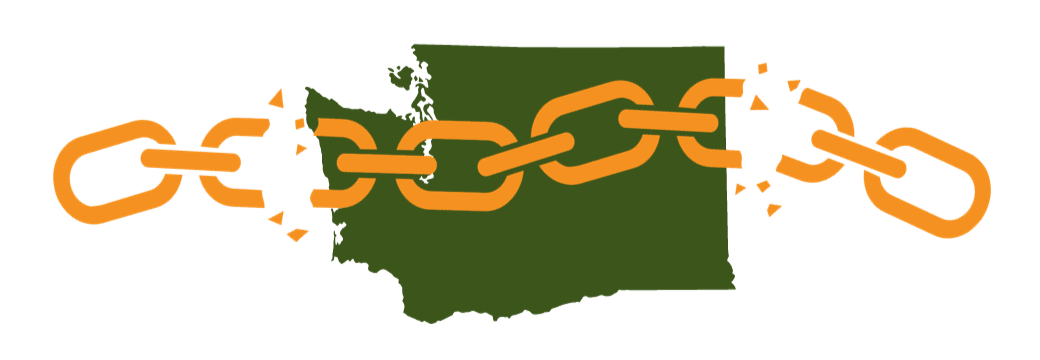
In the next few weeks, the Washington State Department of Ecology is set to deliver a decision on whether to turn Washington’s cap and trade program into a carbon über-market tying our climate future to California and Québec. Rather than requiring California and Québec to meet Washington standards, Ecology this week announced it is prepared to offer up legislation this coming session that would weaken the Washington law.
Our take is that linkage would only accelerate and accentuate the issues of the Washington carbon market, including the unequal distribution of environmental benefits and burdens, slower carbon emissions reductions, and reduced accountability to local communities.
Trading pollution through a global carbon market isn’t some far-out scheme, but rather, a real strategy of carbon fundamentalists who believe the most “efficient”—rather than “effective” or “just”—way to tackle carbon pollution is to move all carbon allowances (i.e. permits to pollute) into one marketplace where the permits are traded at the lowest possible cost. They even got this desire written into the 2021 Climate Commitment Act. However, the Department of Ecology, which is the agency tasked with running the program, was explicitly told it couldn’t pursue linkage until certain criteria were met, including a determination that linkage wouldn’t harm overburdened communities.
According to the law, Ecology must determine, in part, that linkage will:
- reduce the cost of the cap and trade program compliance and administration;
- not adversely impact Washington’s ability to achieve the emission reduction limits;
- have provisions to ensure linked areas have provisions to ensure the distribution of benefits from the program to vulnerable populations and overburdened communities; and
- not yield net adverse impacts to either jurisdictions’ highly impacted communities or analogous communities in the aggregate, relative to the baseline level of emissions.
Our assessment is that linkage is not appropriate, as it will yield net adverse impacts to highly impacted communities and will negatively affect Washington’s abilities to achieve its stated emission reduction limits.
The results from California’s market already show that there is continued risk to environmental justice impacted communities from cap-and trade that would remain the same or potentially get worse under linked markets. Multiple reports out of California have shown that while the cap-and-trade program may have raised the cost of emitting some fossil fuels, the rates at which emissions have been changed are not equal. Studies determined that communities of color “are still more exposed to pollution from facilities such as oil refineries when compared to white communities.” Further, “[s]ome of those communities even saw the level of emissions grow worse since the start of the cap and trade program” (from the Los Angeles Times).
Similarly, multiple studies have drawn into question the impact of offsets for overburdened communities and vulnerable populations. Linking Washington’s cap-and-trade model only serves to exacerbate these risks for both California and Washington residents.
In its preliminary report on the potential impacts of linking carbon markets, Ecology made assumptions about the effects of linkage on overburdened communities without sufficient evidence. The department claimed benefits to overburdened communities but solely based its finding on monetary benefits from investments. The department even acknowledged that Québec does not have mandatory funding targets, as do California and Washington—instead, the agency hitches its finding that Québec distributes benefits to overburdened communities to the existence of an overarching “Green Economy Plan.”
Ecology also did not come to a determination at all about whether linkage would cause adverse impacts to overburdened communities, instead claiming that it would continue to study the issue. It appears that Ecology believes efforts to pursue linkage should move forward on purported economic benefits alone, despite not having done anywhere near the same level of rigorous research and forecasting for effects of this decision on frontline communities as it did for economic impacts on polluting participants.
It remains unclear why Ecology is still contemplating linkage without a clear understanding of how linkage would affect the communities already most impacted by greenhouse gas emissions and climate change. After all, the carbon market established by the Climate Commitment Act was meant to “contribute to a healthy environment for all of Washington’s communities.”

A drop in the price of carbon will lead to less revenue achieved for Climate Commitment Act funds that can benefit overburdened communities with climate mitigation and resilience.
There are a number of mismatches in policy that have led to a glut of allowances (one allowance is a permit to continue emitting one metric ton of carbon dioxide) available in the linked markets of California and Québec.
Though Washington may have policy measures in place that reduce the number of allowances available for purchase at auction in accordance with the number of offsets purchased, California does not. Further, while in Washington only certain industries are granted free allowances, in California all industrial facilities receive free allowances. Combined with the fact that both Washington and California allow for the “banking” of carbon allowances without expiration dates, its clear there is a strong risk of having an overabundance of banked allowances that polluters could utilize anytime they deem that the auctioned price of carbon is too high.
While linkage reduces the cost of compliance for emitters, especially through opening up polluters to sharing in this surplus of carbon allowances, it also reduces the revenue going to accounts funded by the carbon markets. This in turn means less funds going to overburdened communities, which would pose a problem for overburdened communities in all linked markets, not just Washington State.
Linking Washington’s market to California’s would allow for a glut of allowances to flood the joint market and drive down the price of carbon, leading to reduced funding for overburdened communities and less incentive for covered emitters to reduce the pollution they generate.
While carbon pricing may be successful in raising revenue to invest in a Just Transition, it may have only modest effects in reducing pollution in the short term on higher income consumers—who can pay to pollute—and can be punitive to lower income consumers with greater barriers to transitioning behaviors or technologies. Ecology also recognizes that linkage does not necessarily mean that consumers will pay less, because the decision as to whether or not businesses pass their reduced cost of compliance down to customers is outside of public control.
Ultimately, linking carbon markets will only exacerbate the game of trading pollution in markets for the financial benefit of polluters, rather than focusing on the need to make tangible changes here in Washington State that address the harm continued pollution inflicts on our frontline communities.
Understanding “Overburdened Communities” and “Vulnerable Populations”
Front and Centered generally uses the term “frontline communities” as a descriptor for communities of color, Indigenous peoples, and people with lower incomes who are hit first and worst by environmental damage and climate change. However, terms like Overburdened Communities and Vulnerable Populations are used in law, and their definitions affect which communities are targeted for resource allocation.
Therefore, while we generally avoid words like “vulnerable” and “overburdened” due to the disempowering and othering nature of such labels, they are used throughout this analysis to conform to the language of the law and will remain capitalized to signify that they are both terms of art:
Overburdened Community as defined in HEAL means a geographic area where vulnerable populations face combined, multiple environmental harms and health impacts, and includes, but is not limited to, highly impacted communities.
Additionally, the CCA defines Overburdened Community to include health impacts or risks due to exposure to environmental pollutants or contaminants through multiple pathways, which may result in significant disparate adverse health outcomes or effects. These include Highly Impacted Communities (as used in the Clean Energy Transformation Act), “Indian Country,” and populations who may face disproportionately greater health risks due to exposure to environmental contaminants and pollutants outside of the geographic area in which they reside based on their use of traditional or cultural foods and practices (such as Native Americans and immigrant populations).
Vulnerable Populations are population groups that are more likely to be at higher risk for poor health outcomes in response to environmental harms. Vulnerable populations include, but are not limited to: racial or ethnic minorities; low-income populations; populations disproportionately impacted by environmental harms; and populations of workers experiencing environmental harms.


